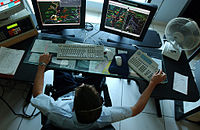Automatic Identification System

An automatic identification system, or AIS for short, is a very useful tool for boats and ships that helps them see and communicate with each other when they are on the water. Let's imagine that you are playing in a pool with some of your friends, and you all have special armbands that can communicate with each other. Whenever you move around in the pool, your armband sends a signal that tells the other armbands where you are and how fast you're moving. This way, your friends always know where you are in the pool and can avoid bumping into you.
AIS works in a very similar way, but instead of armbands, boats and ships have special devices that can communicate with each other using radio signals. These devices can tell other vessels where they are, how big they are, how fast they're moving, and what direction they're headed in. This information is extremely helpful for avoiding collisions, especially in busy shipping lanes or in areas where there are a lot of boats.
To make sure that everyone is using AIS properly, there are rules and regulations that boats and ships have to follow. For example, they have to turn on their AIS devices whenever they are underway (i.e., moving), and they have to keep them on at all times except in certain circumstances. If a boat or ship doesn't have AIS or isn't using it properly, they can be fined or even banned from certain waters.
So, in summary, AIS is a system that helps boats and ships communicate with each other using radio signals. It tells them important information about their location, speed, and direction, which helps them avoid collisions and stay safe on the water. And just like you and your friends with your armbands in the pool, AIS is a really helpful tool that makes it easier for everyone to play together safely!
AIS works in a very similar way, but instead of armbands, boats and ships have special devices that can communicate with each other using radio signals. These devices can tell other vessels where they are, how big they are, how fast they're moving, and what direction they're headed in. This information is extremely helpful for avoiding collisions, especially in busy shipping lanes or in areas where there are a lot of boats.
To make sure that everyone is using AIS properly, there are rules and regulations that boats and ships have to follow. For example, they have to turn on their AIS devices whenever they are underway (i.e., moving), and they have to keep them on at all times except in certain circumstances. If a boat or ship doesn't have AIS or isn't using it properly, they can be fined or even banned from certain waters.
So, in summary, AIS is a system that helps boats and ships communicate with each other using radio signals. It tells them important information about their location, speed, and direction, which helps them avoid collisions and stay safe on the water. And just like you and your friends with your armbands in the pool, AIS is a really helpful tool that makes it easier for everyone to play together safely!
Related topics others have asked about:
